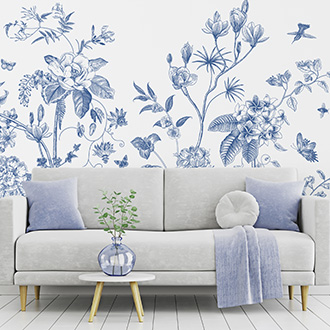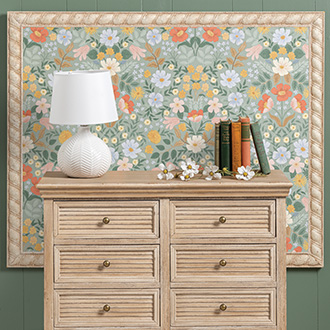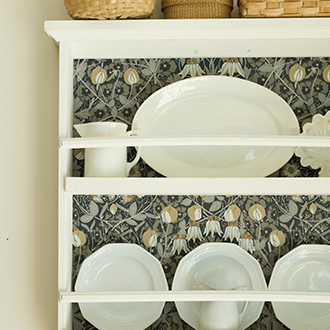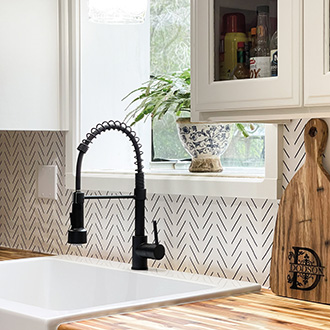SAVE 57%!
Subscribe Now

A blue botanical mural provides a striking backdrop. Made to order, this mural can be ordered in paste or peel-and-stick paper.
Photograph courtesy of Wallsauce, wallsauce.com.

Accent an area in your room with an oversize frame featuring a panel of peel-and-stick wallpaper that coordinates with your decor. This easy option allows you to use a favorite paper without the cost of covering a whole room.
Bramble Garden Wallpaper in Sage Courtesy of Rifle Paper Co., https://riflepaperco.com.

Wallpaper can be used to give furniture a fresh look, as Anna Price of Sky Lark House did when she applied peel-and-stick paper to the back of a plate rack.
Designed and Photographed by Anna Price of skylarkhouse.com.

A temporary peel-and-stick backsplash is a great choice if you're not ready to decide on a more permanent material such as tile. Do Dodson gave her kitchen a quick update with a vinyl paper. She recommends choosing a pattern that is easy to match.
Designed and Photographed by Do Dodson of dododsondesigns.com.
Not that long ago, wallpaper was seen as dated design. Many homeowners were eager to strip away the busy or kitschy patterns of the past in favor of the more minimalist look of painted walls. Plus, there was the perception of wallpaper being a hassle both to install and remove, which offered another reason to avoid it. In the last several years, however, new technology and patterns are inspiring people to take another look at wallpaper as a versatile way to inject personality into their living spaces.
Creative Possibilities
Several factors are contributing to the resurgence of wallcoverings. For one, wallpaper offers an unlimited opportunity for creativity. From bold geometric patterns to delicate florals and eyecatching murals, wallpaper allows for design choices that are often more visually striking than paint alone. And thanks to advancements in printing technology, there are now a wide variety of textures, colors and designs available at every price point.
Trending Textures
With features such as embossed patterns, natural fibers, and dimensional designs that help improve a room's acoustics, textured wallpaper is moving into the spotlight. Natural
materials such as grasscloth, bamboo, sisal or cork appeal to those seeking eco-friendly options. In addition to touchable texture, patterns with visual dimension are also popular, including brick and tile designs. Some companies are even producing wallpapers that mimic fabrics, including twill, linen, velvet, silk, canvas and more.
Plethora of Patterns
From timeless classic designs to more modern motifs, there is a wallpaper pattern to fit every style. Popular farmhouse picks typically feature simple designs with natural elements like flowers and wildlife, often in muted shades of white, cream, blue and green. Plaids, tone-on-tone patterns and vintage-inspired looks, like those of famed designer William Morris, are also attracting notice.
For those seeking a more custom alternative, there are companies that provide print-on-demand wallpapers. You can upload your own patterns or select from those created by other independent artists.
High-Impact Murals
Mural-style wallpapers can transform an entire wall into a work of art, with scenic landscapes, larger-than-life texture or oversize florals. This makes wallpaper particularly
appealing for feature walls, accent spaces, or rooms where a touch of drama is desired. While accent wall murals are still popular, Wallsauce, a company that makes custom wallpaper murals, expects to see increased interest in wraparound murals that extend around a room.
New Technology
Another driving force behind wallpaper's comeback is manufacturers' response to the growing demand for sustainability in design. Many modern wallpapers are made with eco-friendly materials and nontoxic inks, catering to environmentally conscious consumers.
Peel-and-stick options also make wallpaper easier to apply and remove, reducing waste and making it a more approachable choice for renters or those who like to change up their decor frequently.
And wallpaper is more accessible than ever before. You can browse for patterns online (and even order samples) rather than heading to a store to pore over catalogs.
Ultimately, there are many reasons wallpaper is back to being a design darling, but the biggest reason to include it in your home is because it offers a versatile opportunity to add another layer of personality to your rooms.

